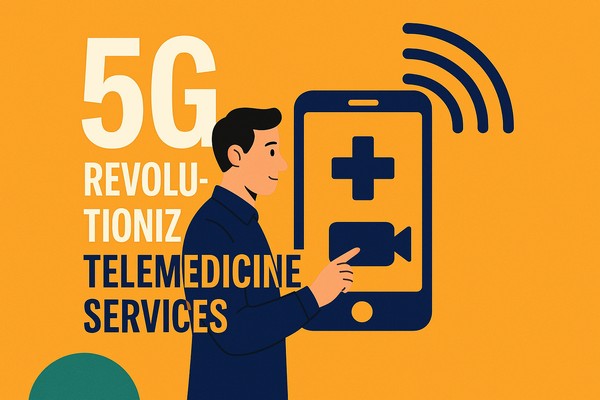The advent of 5G technology has sent shockwaves across various industries, and healthcare is no exception. The integration of 5G with telemedicine services is transforming the way medical care is delivered, making it more efficient, accessible, and personalized. In this article, we will explore how 5G is revolutionizing telemedicine services and what this means for the future of healthcare.
The Limitations of Traditional Telemedicine
Traditional telemedicine services have been around for a while, but they have been hampered by limitations such as poor connectivity, lag, and low-quality video. These issues have made it challenging for healthcare providers to deliver high-quality care remotely. However, with the advent of 5G, these limitations are being addressed.
What is 5G and How Does it Work?
5G is the fifth generation of wireless technology, designed to provide faster data speeds, lower latency, and greater connectivity. It operates on a higher frequency band than its predecessors, allowing for a significant increase in data transfer rates. This enables healthcare providers to transmit high-quality video, images, and other medical data in real-time.
The Impact of 5G on Telemedicine
The impact of 5G on telemedicine is multifaceted. Faster Data Transfer Rates enable healthcare providers to transmit large files, such as medical images and videos, quickly and efficiently. Lower Latency ensures that there is minimal delay in communication between healthcare providers and patients, allowing for more effective real-time consultations.
Enhanced Patient Care
5G-enabled telemedicine services are enhancing patient care in several ways. Remote Monitoring allows healthcare providers to track patients’ vital signs and other health metrics in real-time, enabling early intervention and prevention of complications. Virtual Consultations enable patients to receive medical care from the comfort of their own homes, reducing the need for hospital visits.
Increased Accessibility
5G is increasing accessibility to healthcare services, particularly in Rural and Underserved Areas. With 5G-enabled telemedicine, patients in these areas can access medical care that was previously unavailable to them. This is particularly significant for patients with mobility issues or those who live in areas with limited healthcare resources.
Improved Medical Education and Training
5G is also improving medical education and training. Virtual Reality (VR) and Augmented Reality (AR) are being used to create immersive learning experiences for medical students and professionals. This enables them to practice complex procedures and stay up-to-date with the latest medical techniques.
The Role of 5G in Remote Surgery
5G is playing a crucial role in remote surgery, enabling surgeons to perform operations remotely with precision and accuracy. Tactile Feedback technology, enabled by 5G, allows surgeons to feel tactile sensations while operating remotely, making it possible to perform complex procedures.
The Benefits of 5G-Enabled Telemedicine
The benefits of 5G-enabled telemedicine are numerous. Increased Efficiency enables healthcare providers to manage their workload more effectively, reducing the burden on hospitals and clinics. Cost Savings are also significant, as patients reduce their need for travel and healthcare providers reduce their operational costs.
Enhancing Patient Engagement
5G-enabled telemedicine is enhancing patient engagement by providing patients with more control over their care. Patient Portals enable patients to access their medical records, communicate with healthcare providers, and manage their appointments.
The Future of Telemedicine
The future of telemedicine is exciting, with 5G enabling new and innovative applications. Artificial Intelligence (AI) and Machine Learning (ML) are being integrated with telemedicine services, enabling healthcare providers to analyze large datasets and make more informed decisions.
Addressing Security Concerns
As with any new technology, there are security concerns associated with 5G-enabled telemedicine. Data Encryption and Secure Authentication are being implemented to ensure that patient data is protected.
The Economic Benefits of 5G-Enabled Telemedicine
The economic benefits of 5G-enabled telemedicine are significant. Reduced Healthcare Costs are being achieved through reduced hospital readmissions, reduced length of stay, and reduced travel costs.
The Impact on Chronic Disease Management
5G-enabled telemedicine is having a significant impact on chronic disease management. Remote Monitoring enables healthcare providers to track patients’ vital signs and other health metrics in real-time, enabling early intervention and prevention of complications.
The Role of 5G in Mental Health Care
5G is playing a crucial role in mental health care, enabling patients to access therapy and counseling services remotely. Virtual Therapy Sessions are becoming increasingly popular, providing patients with more flexibility and convenience.
The Future of Remote Patient Monitoring
The future of remote patient monitoring is exciting, with 5G enabling new and innovative applications. Wearable Devices and IoT Devices are being used to track patients’ vital signs and other health metrics in real-time.
The Impact on Healthcare Infrastructure
5G-enabled telemedicine is reducing the burden on healthcare infrastructure, enabling healthcare providers to manage their workload more effectively. Reduced Emergency Department Visits are being achieved through early intervention and prevention of complications.
The Role of 5G in Public Health
5G is playing a crucial role in public health, enabling healthcare providers to track and respond to outbreaks more effectively. Real-Time Surveillance enables healthcare providers to identify and respond to public health threats in real-time.
The Benefits for Healthcare Providers
The benefits of 5G-enabled telemedicine for healthcare providers are numerous. Increased Productivity enables healthcare providers to manage their workload more effectively, reducing the burden on hospitals and clinics.
The Patient Experience
The patient experience is being transformed by 5G-enabled telemedicine. Personalized Care is being delivered through the use of data analytics and AI, enabling healthcare providers to tailor their care to individual patients’ needs.
The Challenges Ahead
While 5G-enabled telemedicine is transforming the healthcare landscape, there are challenges ahead. Regulatory Frameworks need to be developed to ensure that 5G-enabled telemedicine services are safe and effective.
In conclusion, 5G is revolutionizing telemedicine services, enabling healthcare providers to deliver high-quality care remotely. The benefits of 5G-enabled telemedicine are numerous, from increased accessibility and efficiency to enhanced patient care and engagement. As 5G continues to evolve, we can expect to see even more innovative applications in the healthcare sector. With its potential to transform the way medical care is delivered, 5G-enabled telemedicine is an exciting development that is set to shape the future of healthcare.








